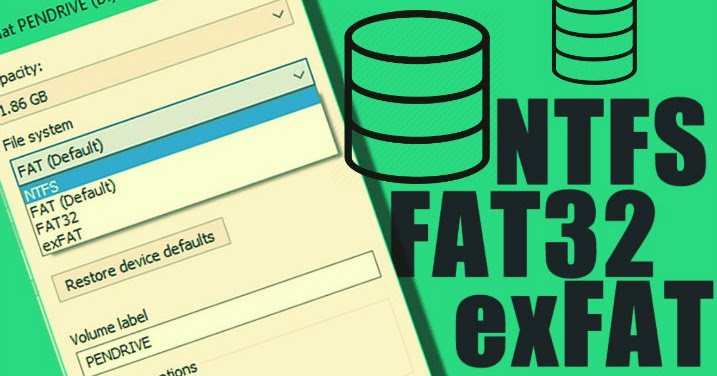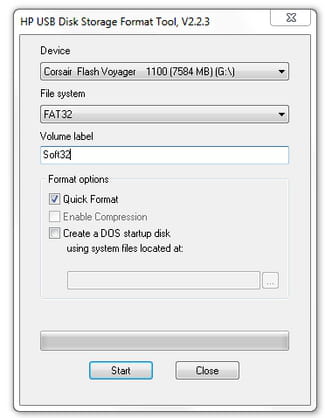
There are mainly three types of FAT drives: FAT12, FAT16 and FAT32. Somepeople used to think DOS only support FAT12 and FAT16 drives, not FAT32 drives.However, this is totally wrong. The fact is: only very old versions of DOS don'tsupport FAT32 drives, while most newer versions of DOS support FAT32 as well asFAT12 and FAT16 drives. Below are lists of the typical types and versions of DOSthat do or do not support FAT32 drives:
Part I: Typical types and versions of DOS that support FAT32 drives:
FAT32, NTFS, and exFAT are the three file systems created by Microsoft which used to store data on storage devices. The difference between FT32, NTFS, and exFAT is the storage size that the file. How to format A USB Thumb Drive FAT32, exFAT. Please note MS-DOS(FAT) is Disk Utility's name for FAT32. Call of duty black ops 2 play now online free. The FAT file system was first used in MS-DOS where the maximum size of the hard drive can be 32 MB consisting sectors of 512 K partitions. It is commonly used in removable drives and storage devices. The maximum size of a file in the FAT32 drive cannot be exceeded more than 4 GB and the partitions made in FAT32 should be smaller than 8 TB. FAT stands for 'File Allocation Table', FAT and FAT16 are the same. This was widely used during the Under DOS and early versions of Windows 95 era when the hard drive capacity is generally small ( less than 2 GB). Floppy drive is always formatted in this format. Apple do say here to use 'A blank 16 GB or larger external USB 2 flash drive, formatted as MS-DOS (FAT)' but they are either using FAT in the general rather than specific sense (which is confusing) or the document is wrong.

There are mainly three types of FAT drives: FAT12, FAT16 and FAT32. Somepeople used to think DOS only support FAT12 and FAT16 drives, not FAT32 drives.However, this is totally wrong. The fact is: only very old versions of DOS don'tsupport FAT32 drives, while most newer versions of DOS support FAT32 as well asFAT12 and FAT16 drives. Below are lists of the typical types and versions of DOSthat do or do not support FAT32 drives:
Part I: Typical types and versions of DOS that support FAT32 drives:
FAT32, NTFS, and exFAT are the three file systems created by Microsoft which used to store data on storage devices. The difference between FT32, NTFS, and exFAT is the storage size that the file. How to format A USB Thumb Drive FAT32, exFAT. Please note MS-DOS(FAT) is Disk Utility's name for FAT32. Call of duty black ops 2 play now online free. The FAT file system was first used in MS-DOS where the maximum size of the hard drive can be 32 MB consisting sectors of 512 K partitions. It is commonly used in removable drives and storage devices. The maximum size of a file in the FAT32 drive cannot be exceeded more than 4 GB and the partitions made in FAT32 should be smaller than 8 TB. FAT stands for 'File Allocation Table', FAT and FAT16 are the same. This was widely used during the Under DOS and early versions of Windows 95 era when the hard drive capacity is generally small ( less than 2 GB). Floppy drive is always formatted in this format. Apple do say here to use 'A blank 16 GB or larger external USB 2 flash drive, formatted as MS-DOS (FAT)' but they are either using FAT in the general rather than specific sense (which is confusing) or the document is wrong.
| MS-DOS 7.10 | This is the most useful and up-to-date version of DOS with FAT32 and LFN (Long File Names) support, and has the best compatibility and usability. It fully supports Win3.x/9x GUI running on top. |
| PC-DOS 7.10 | With FAT32 support, however only a boot disk is available, and has problems with some drives and programs. |
| DR-DOS 7.01.x WIP/7.05/8.0 | With FAT32 support, however only a boot disk and few files are available, and has less compatibility than MS-DOS 7.10. Also, DR-DOS 8.0 is not available for download. |
| ROM-DOS 7.10 | With FAT32 and LFN support, however has less compatibility than MS-DOS 7.10. And only DEMO version is available for download. |
| PTS-DOS 32 [7.10] | With FAT32 support, however only DEMO version is available for download, with very limited utilities and less compatibility. |
| FreeDOS Kernel 2035 [7.10] | The most promising open-source DOS with FAT32 support, however has many limitations and bugs for the time being. |
| RxDOS 6.2 | With FAT32 and LFN support, however very buggy and unstable, and not complete. |
| Real/32 DOS 7.94 | With FAT32 and multi-tasking support, however it's not for download at all, and has much less compatibility than MS-DOS 7.10. |
So, from the above table, we can know that MS-DOS 7.10 is the best DOS of alldifferent types/versions of DOS in the world. You can install MS-DOS 7.10 fromits own installer. MS-DOS 7.10 boot disks/CD andMS-DOS 7.10 Full Installation Set are available from:
Part II: Typical types and versions of DOS that do NOT support FAT32 drives:
| MS-DOS 6.22 | This is a classic yet very outdated and ancient version of MS-DOS. |
| PC-DOS 7.0/2000 | The old and classic PC-DOS 2000 is still used by some people. |
| DR-DOS 7.0/7.03 | No official versions of DR-DOS support FAT32 drives. |
| PTS-DOS 2000 | Not used by many people, and no FAT32 support. |
Ms-dos Fat Vs Fat32
There is NOT any stable and usable separate FAT32 driver for these old versions ofDOS (BTW: DRFAT32 is very unstable and unusable, and has no LFN support). Evenif all drives are in FAT16 format, older versions of DOS will NOT be able to seeor access larger hard disks, because these older DOSes don't know about LBA andInt13x calls at all. So, inorder to support FAT32, LFN, large hard disks, and more useful stuff natively and stably, users should upgrade their DOS, from MS-DOS 6.22 toMS-DOS 7.10, for example. More information about MS-DOS 7.10 is available from:
Any questions, problems, or suggestions, please feel free to mailme!
The precise manner in which data is organised on a hard disk drive is determined by the file system used. File systems are generally operating system dependent. However, since it is the most widely used PC operating system, most other operating systems' file systems are at least read-compatible with Microsoft Windows.
Fat Or Fat32
The FAT file system was first introduced in the days of MS-DOS way back in 1981. The purpose of the File Allocation Table is to provide the mapping between clusters – the basic unit of logical storage on a disk at the operating system level – and the physical location of data in terms of cylinders, tracks and sectors – the form of addressing used by the drive's hardware controller.
https://iifree.mystrikingly.com/blog/vgurusoft-video-player-1-6-0-2.
The FAT contains an entry for every file stored on the volume that contains the address of the file's starting cluster. Each cluster contains a pointer to the next cluster in the file, or an end-of-file indicator at (0xFFFF), which indicates that this cluster is the end of the file. The diagram shows three files: File1.txt uses three clusters, File2.txt is a fragmented file that requires three clusters and File3.txt fits in one cluster. In each case, the file allocation table entry points to the first cluster of the file.
The first incarnation of FAT was known as FAT12, which supported a maximum partition size of 8MB. This was superseded in 1984 by FAT16, which increased the maximum partition size to 2GB. FAT16 has undergone a number of minor modifications over the years, for example, enabling it to handle file names longer than the original limitation of 8.3 characters. FAT16's principal limitation is that it imposes a fixed maximum number of clusters per partition, meaning that the bigger the hard disk, the bigger the cluster size and the more unusable space on the drive. The biggest advantage of FAT16 is that it is compatible across a wide variety of operating systems, including Windows 95/98/Me, OS/2, Linux and some versions of UNIX.
Dating from the Windows 95 OEM Service Release 2 (OSR2), Windows has supported both FAT16 and FAT32. The latter is little more than an extension of the original FAT16 file system that provides for a much larger number of clusters per partition. As such, it offers greatly improved disk utilisation over FAT16. However, FAT32 shares all of the other limitations of FAT16 plus the additional one that many non-Windows operating systems that are FAT16-compatible will not work with FAT32. This makes FAT32 inappropriate for dual-boot environments, although while other operating systems such as Windows NT can't directly read a FAT32 partition, they can read it across the network. It's no problem, therefore, to share information stored on a FAT32 partition with other computers on a network that are running older versions of Windows.
With the advent of Windows XP in October 2001, support was extended to include the NTFS. NTFS is a completely different file system from FAT that was introduced with first version of Windows NT in 1993. Designed to address many of FAT's deficiencies, it provides for greatly increased privacy and security. The Home edition of Windows XP allows users to keep their information private to themselves, while the Professional version supports access control and encryption of individual files and folders. The file system is inherently more resilient than FAT, being less likely to suffer damage in the event of a system crash and it being more likely that any damage is recoverable via the chkdsk.exe utility. NTFS also journalises all file changes, so as to allow the system to be rolled back to an earlier, working state in the event of some catastrophic problem rendering the system inoperable. Vitamin r 2 56 download free.
FAT16, FAT32 and NTFS each use different cluster sizes depending on the size of the volume, and each file system has a maximum number of clusters it can support. The smaller the cluster size, the more efficiently a disk stores information because unused space within a cluster cannot be used by other files; the more clusters supported, the larger the volumes or partitions that can be created.
Adventist family feud. The table below provides a comparison of volume and default cluster sizes for the different Windows file systems still commonly in use: https://downxup788.weebly.com/eico-model-1171-manual.html.
| Volume Size | FAT16 Deltarune ps4 trailer. Cluster Size | FAT32 Cluster Size | NTFS Cluster Size |
|---|---|---|---|
| 7MB – 16MB | 2KB | Not supported | 512 bytes |
| 17MB – 32MB | 512 bytes | Not supported | 512 bytes |
| 33MB – 64MB | 1KB | 512 bytes | 512 bytes |
| 65MB – 128MB | 2KB | 1KB | 512 bytes |
| 129MB – 256MB | 4KB | 2KB | 512 bytes |
| 257MB – 512MB | 8KB | 4KB | 512 bytes |
| 513MB – 1GB | 16KB | 4KB | 1KB |
| 1GB – 2GB | 32KB | 4KB | 2KB |
| 2GB – 4GB | 64KB | 4KB | 4KB |
| 4GB – 8GB | Not supported | 4KB | 4KB |
| 8GB – 16GB | Not supported | 8KB | 4KB |
| 16GB – 32GB | Not supported | 16KB | 4KB |
| 32GB – 2TB | Not supported | Not supported | 4KB |
